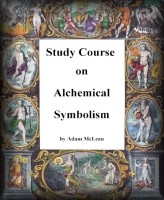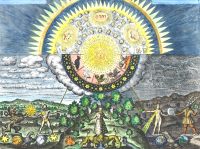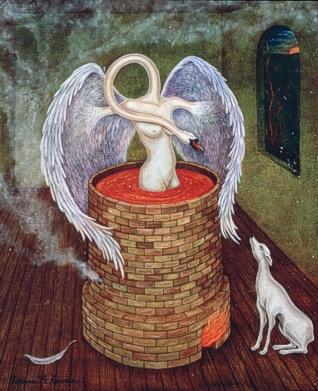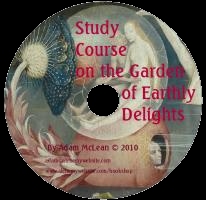|
|
Alchemy as a proto-chemistryBack to introduction.Alchemy has always had a basis in practical laboratory experiments, and processes for working with substances. Although alchemy continued to be explored throughout the 18th century, during the 19th century, the rise of the new focussed sciences of physics, chemistry, biology etc., led to alchemy being marginalised and considered irrelevant to this emerging new scientific attitude. This can be seen in the fact that there are almost no new alchemical works published in the 19th century. Alchemy had to wait till the 20th century to be seen as a proto-chemistry worthy of study and investigation. In the last quarter of the 19th century, partly as a reaction again a science which sought to reduce everything to purely physical processes, there was a revival of interest, focussed in the Theosophical Society and the occult revival in France, in a spiritual view of life. In the wake of this new movement a number of people began to collect alchemical texts and begin alchemical experiments. One of the first to begin practical alchemical experiments at that time was W.A. Ayton. During the early 20th century the newly discovered phenomenon of radioactivity, and Rutherford's experiment in atomic transmutation, led to a number of people trying to rediscover a scientific basis for alchemical transmutation, however, all of these proved fruitless. In 1926 a book Le Mystere des Cathedrales was published in Paris supposedly by an adept called Fulcanelli. Although this book presents (as did Fulcanelli's later work Les Demeures Philosophales) an alchemical interpretation of monumental sculpture on Gothic cathedrals and later buildings, various myths about Fulcanelli practising physical alchemy and achieving the goal of transmutation began to circulate. Most of these myths were focussed around Eugene Canseliet, who wrote a number of books, practised physical alchemy, and gathered a small group of students. The whole matter surrounding Fulcanelli has been purposively surrounded in mystery by the various personalities involved in creating the myth, and it seems that little now of any value can be gleaned about this veiled personality. In the 1930's, a physiotherapist called Archibald Cockren set up an alchemical laboratory in London and began to produce oils from metals, which he used in healing. Cockren drew most of his inspiration from the works of the 15th century English adept George Ripley, as well as from Basil Valentine and Ramon Lull. He wrote quite openly of his work in Alchemy Rediscovered and Restored, 1940. Although he undoubtedly sought for the philosophers stone, Cockren used alchemy to make medicines. He died during the Second World War when a bomb landed on his laboratory. In France Armand Barbault began in 1948 to rework a process depicted in the 17th century alchemical work, the Mutus Liber, published at La Rochelle in1677. This involved saturating plant material with dew and perfoming a complex series of cyclical distillations. Barbault wrote openly about his process in his 'Gold of a Thousand Mornings', first published in French in 1969. His aim was to produce medicines rather than transmutation. During the 1960's Roger Caro published a series of books Pleiade Alchimique and Concordances Alchimiques, as well as a photographic sequence showing him performing the alchemical process and its sequence of colour changes. The most important figure of twentieth century practical alchemy must be Albert Riedel. In 1960 he issued The Alchemist's Handbook (Manual for Practical Laboratory Alchemy). In Salt lake City he set up a centre for his Paracelsus Research Society and began giving lessons in practical alchemy. He devised a process for the spagyric preparation of substances from vegetable material, herbs, etc., using modern chemical apparatus and laboratory techniques. These series of lessons were well attended, and he had hundreds of members of his group. Later there developed centres in Germany and Australia working with his ideas and practices. The aim of Albertus' work was the preparation of medicinal remedies, or alchemical preparations which one would take to preserve health. The main technique for the spagyric preparation of a substance was to separate by heating, the Salt, Sulphur and Mercury of a substance then re-unite these again to give a powerfully charged medicine. His work continues to inspire people to practice this spagyric technique.
Jean Dubuis founded the L.P.N in 1979. This group published a newsletter entitled 'Le petit Philosophe de la Nature' and generated a large membership. Dubuis took various elements from different writers and practitioners, and wove them into a coherent sequence of lessons, which became the basis for the work of the LPN. In the 1990's the LPN spread from France to America, where there developed a thriving group, which organised events, published an alchemical magazine and issued books and lessons in alchemy. The LPN seemed refreshingly open in its approach to alchemy. It closed as an active organisation a few years ago, though one can still obtain the lessons. |
Introduction Reading list Some quotations Frequently asked questions Common misconceptions Timeline The different ways of looking at alchemy -------
Proto-chemistrySymbolism Psychology allegorical journeys mysticism metaphysical historians of ideas  Study Courses
Study Courses Alchemical, astrological and emblematic art prints  Alchemy and art  Art books Series  Study course on Bosch's Garden of Earthly Delights New Hieronymus Bosch Website |